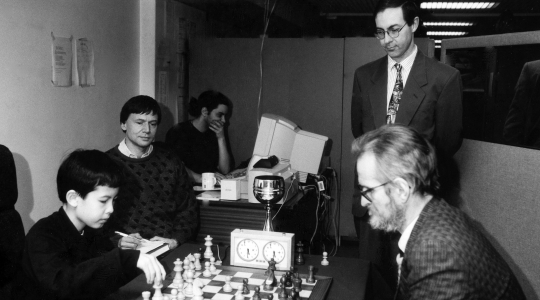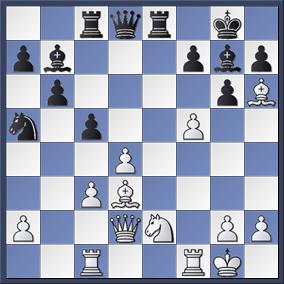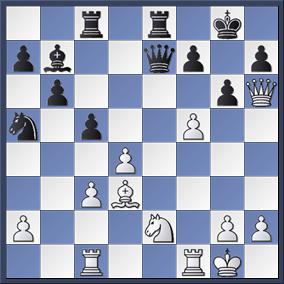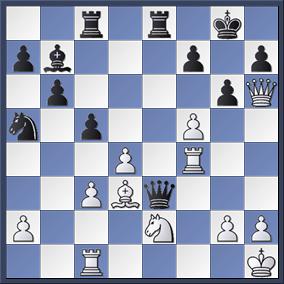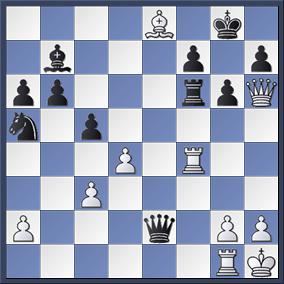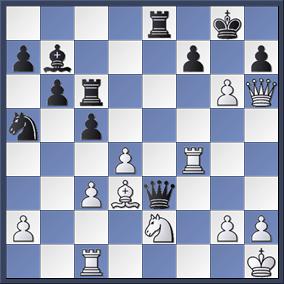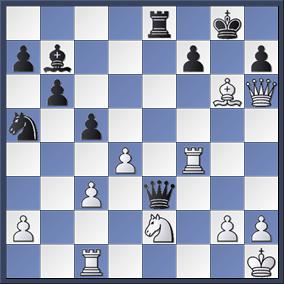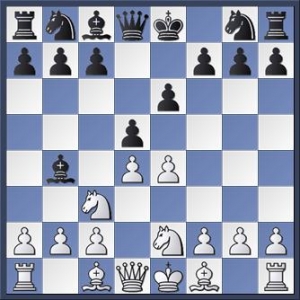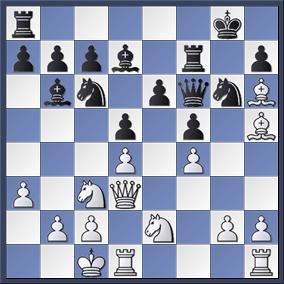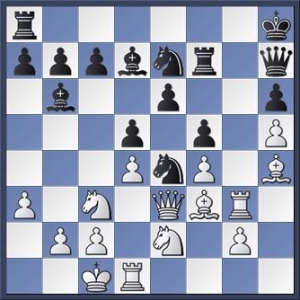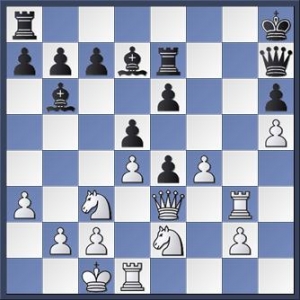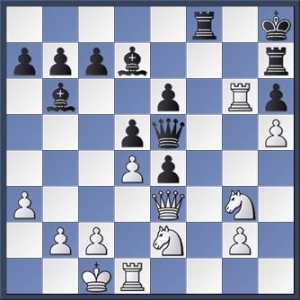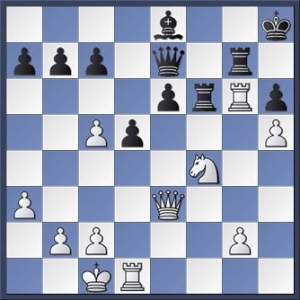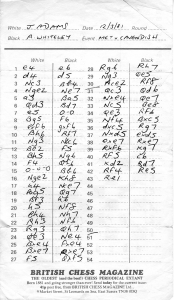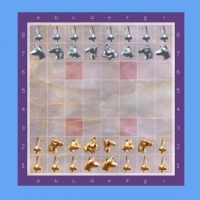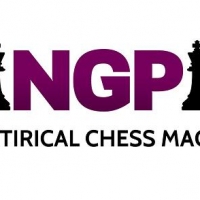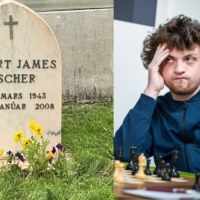– asks Jimmy Adams
Following my recent interview for Kingpin, conducted by Sarah Hurst, the editor has asked me to provide some documentary evidence that once upon a time I really did play chess and not just talk about it. Well, it’s been quite a while since I engaged in over-the-board combat, so readers will have to put up with some old-fashioned chess from the pre-computer era and decide for themselves whether or not these games of mine have already passed their sell-by date.
The first such encounter I want to show you was played in Holland’s world famous chess festival, which is nowadays held every year in Wijk aan Zee. Here, grandmasters and amateurs play side by side in their respective tournaments in a friendly yet competitive atmosphere.
J.Mol – Jimmy Adams
Beverwijk 1967
Grunfeld Defence
1.d4 Nf6 2.c4 g6 3.Nc3 d5 4.cxd5 Nxd5 5.e4 Nxc3 6.bxc3 Bg7 7.Bc4 0–0 8.Ne2 Nc6 9.0–0 b6 10.Be3 Bb7
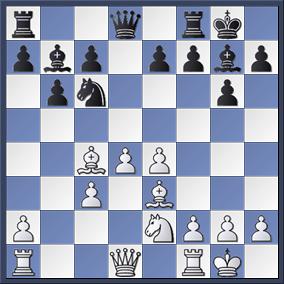 Though Bent Larsen had lost to Boris Spassky in the grandmaster tournament with this development of pieces, I thought it had a lot of potential and so decided to try it out myself.
Though Bent Larsen had lost to Boris Spassky in the grandmaster tournament with this development of pieces, I thought it had a lot of potential and so decided to try it out myself.
11.f4 e6 12.f5
If I remember correctly, my opponent had stood in as a late replacement when one of the original entrants had pulled out of our all-play-all section of ten players. So I had no idea of his playing strength. One thing was clear, however – he was moving quickly and wasting no time in coming after my king.
12…Na5 13.Bd3 exf5 14.exf5 Re8 15.Qd2 c5
When I was on a trip to Holland in 1979, I took the opportunity to visit another traditional tournament, held in Tilburg in the south of the country. There I was amused to see that a game between Spassky and Hubner had reached the same position as this – over ten years later! Hubner continued instead with 15…Be4, but lost after 16.Bg5. However, why exchange such a fine bishop which bears down on White’s vulnerable g2 square?
16.Rac1
16.dxc5 bxc5 17.Bxc5 Qd5 threatens mate on g2 as well as the queen’s bishop.
16…Rc8 17.Bh6
17…Bxh6
Though it looks treacherous, I could have gone for the win of a piece by 17…c4 since after 18.Bxg7 (18.Bb1 Bxh6 19.Qxh6 Rxe2 and if 20.f6 Rxg2+ followed by mate with the queen’s bishop.) 18…cxd3 19.fxg6 (19.Qh6 Rxe2 20.Rf4 Qd5 threatening mate on g2; while if 19 Ng3 Kxg7 20.f6+ Kh8 21.Qh6 Rg8 22.Rf4, the threat of 23.Qxh7+! mating can be parried simply by 23…g5) 19…Rxe2 20.gxf7+ Kxg7 21.f8(Q)+ Qxf8 22.Qg5+ Kh8 23.Rxf8+ Rxf8, although Black loses his queen, he wins the game. But I’m still glad that I played the way I did, as some spectacular tactics now emerge.
18.Qxh6 Qe7
Now 18…c4 loses to 19.f6.
19.Rf4
Bravely avoiding an exchange of queens by …Qe3+. If 19.Nf4, with a similar idea, then 19…cxd4 20.f6 Qf8! and not 20…Qxf6 21.Nh5! Qe5 22.Nf6+.
19…Qe3+ 20.Kh1
20…Rc6!
A neat way to defend and attack at the same time. Not 20…c4 21.f6 mating. Nor 20…Qxd3 because of 21.f6 Bxg2+ 22.Kg1! Qe3+ 23.Kxg2 Qxe2+ 24.Kh1 winning. And, finally, if 20…Bxg2+ 21.Kxg2 Qxd3 22.f6 Rxe2+ (22…Qxe2+ 23 Kh1) 23.Kh1 Rxh2+ 24.Kxh2 Qe2+ 25.Kg3 Qe3+ 26.Kh4 leaves Black with no more credible checks.
21.fxg6
My opponent played this confidently. After 21.Rh4 Qxh6 22.Rxh6 c4 Black wins a piece, while 21.f6 allows 21…Rxf6 exploiting the pin on the rook. However, I also had to anticipate the possibility of 21.Bb5, which would be met by the surprising 21…a6! Then 22.f6 (on 22.Bxc6, I would have continued as in the game) 22…Rxf6 23.Bxe8 (if 23.Rxf6 Bxg2+ 24.Kxg2 Qxh6 25.Bxe8 Qg5+ and 26…Qxf6 wins) 23…Qxe2 24.Rg1 (to stop the mate)
Qe3-e4-e2 – a striking queen manoeuvre!
24…Qe3! 25.Rgf1 (25 Rh4 allows an economical finish: 25…Bxg2+! 26.Rxg2 – 26.Kxg2 Qf3 mate – 26…Rf1+ 27.Rg1 Qf3 mate) and now the prettiest way to win is 25…Qe4!! (threatening mate) 26.R4f3 (26.R1f3 Qe1+ 27.Rf1 Qxf1+! mates; or 26.R4f2 Qxg2+! 27 Rxg2 Rxf1 mate) 26…Qe2! (threatening 27…Qxf1+! again!) 27.Qc1 Bxf3 28.Rxf3 Rxf3 29.gxf3 Qxe8 and wins.
21…Rxg6!!
Shock tactics.
22.Bxg6
If 22.Qh5 Bxg2 mate. That vulnerable g2 square again…
22…Qxc1+!
More shock tactics. White now sees that 23.Nxc1 Re1+ mates. The whole idea of my last two moves was to divert White’s bishop from its defence of the f1 square, thereby preventing an interposition on f1, stopping the back rank mate. Luring that bishop to c6 or g6 amounts to the same thing!
23.Ng1
Forced.
23…hxg6
Not 23…fxg6? 24.Rf8+! Rxf8 25.Qxc1.
24.Qh4 Qe1
24…Re1 could be met by 25.Qf2.
25.Qf6 Qe7
Black is now a piece ahead, so simplification is the quickest way to victory.
26.Nf3 Qxf6 27.Rxf6 Bxf3 28.gxf3 cxd4 29.cxd4 Rd8 30.Rf4 Nc6 0-1
If I had won my last round game I would have also won the tournament – but I lost. I shall never forget the opening moves of that game. In reply to 1 e4, my opponent played 1…d6, then, after 2 d4, surprised me with 2…f5, turning my customary king’s pawn opening into a queen’s pawn Dutch(!) Defence. I was already half-beaten after only two moves. Nevertheless I did still receive a prize, the very first number of Chess Informator, which, after all these years continues to flourish – just like the splendid Wijk aan Zee tournament itself.
The second game that I’d like to show you was even featured as ‘Game of the Day’, a few years ago on chessgames.com – a fine website packed full of games, data and comments from readers. However, they did make one slight mistake … they attributed the game not to me, but to my grandmaster namesake, Michael Adams!!
Jimmy Adams – Andrew Whiteley
London 1981
French Defence
1.e4 e6 2.d4 d5 3.Nc3 Bb4 4.Nge2
Mostly I found my opponents played 4…dxe4 here, as happened for example in my game against John Century, Eastman Cup 1974, which I conducted in brutal fashion: 5.a3 Be7 6.Nxe4 Nf6 7.N2g3 Nbd7 8.Bd3 0–0 9.Qe2 e5 (A natural freeing move, but because White has a knight on g3 in this line, as opposed to the more usual f3, I had a strong reply.) 10.Nf5 Re8 11.Bg5 exd4 12.0–0–0 Nf8 13.Nxe7+ Qxe7 14.Bxf6 gxf6 15.Nxf6+! Qxf6 16.Qxe8 Qxf2 17.Rde1 Qf4+ 18.Kb1 Qd6 19.Rhf1 Qd7 20.Bxh7+! Kg7 (If 20…Kxh7 21.Rxf7+ wins.) 21.Rxf7+! (Anyway!) 21…Qxf7 22.Re7 Be6 23.Rxf7+ Bxf7 24.Qxa8 1-0. I could say that here I sacked three pieces – knight, bishop and rook – for three kingside pawns!
5.a3 Ba5 6.Qd3 Bd7
This bears some resemblance to the Fort Knox variation, where White’s knight is better placed on f3. Black intends to play 7…dxe4 8 Qxe4 Bc6, gaining time with an attack on the queen, so I continued…
7.e5 0–0 8.Bg5 f6
Challenging the centre, but at the cost of weakening his kingside.
9.exf6 gxf6 10.Bh6 Rf7 11.Ng3 Nbc6
If 11…e5 12.0–0–0 e4 13.Qe3 Nf5 14.Nxf5 Bxf5 15.f3 with aggressive intentions.
12.Be2 f5
On 12…Ng6 I think I would have proceeded with 13.0-0-0 rather than 13.f4 e5.
13.Bh5 Ng6 14.f4
Halting any further advance of Black’s f-pawn, and securing control of the e5 and g5 squares.
14…Qf6 15.0–0–0 Bb6 16.Nge2
16…Kh8
On 16…Qh4 White has 17.g4! and if 17…fxg4 18.Bxg6 winning.
17.h4 Nce7 18.Bg5 Qg7 19.Bf3
Making way for the advance of the h-pawn.
19…h6 20.h5 Nf8
Of course if 20…hxg5 then 21.hxg6+ wins.
21.Bh4 Nh7 22.Rh3
This was an easy choice for me as I always used to develop my rooks this way when I was a beginner!
22…Nf6 23.Rg3 Qh7 24.Qe3
Anticipating Black’s next.
24…Ne4
25.Bxe4 fxe4
If 25…dxe4, I would have continued 26 Rh1, to meet 26…Rg8 with 27 R1h3, preserving a rook on the g-file and leaving Black constantly on guard against a possible invasion there. Then 26…Nd5 would be bad because of 27.Nxd5 exd5 28.Rg6 (intending 29 Bf6+) and if 28…Raf8 then 29 g4 fxg4 30 f5! threatening Rxh6 winning the queen. In general, my plan after 25…dxe4 and 26 Rh1 would then have been to play Qd2, perhaps followed by Nc3-d1-e3 or d4-d5 at some stage, opening the a1-h8 diagonal leading to the enemy king. Black’s queen remains shut in and his cornered king is vulnerable to attack.
26.Bxe7
But now the time has come for the breakthrough.
26…Rxe7
A study of Chigorin’s games had convinced me that knights were superior to bishops!
27.f5!
Opening a diagonal for the queen. 27.Rg6 Be8 28.f5 Bxg6 29 hxg6 Qg7 29.Rh1 also looked pretty good.
27…Qxf5
Of course, 27…exf5 28 Nf4, intending both 29.Ng6+ and 29.Ncxd5, would lose quickly for Black.
28.Rg6!
Cutting off the queen’s diagonal line of retreat as well as hitting the h6 pawn.
28…Rh7 29.Ng3 Qe5
Neatly exploiting the pin on White’s d-pawn, but the queen will soon be a liability on this square. 29…Qf8 30.Rf1 would have allowed White to bring his rook into the attack with gain of time.
30.Nce2!
Vacating the c3 square whilst providing new opportunities for the knight on the kingside.
30…Rf8
31.Qc3!
Attacking the Black queen.
31…Qd6
Though the queen is placed right in the middle of the board, she has only one safe move – and even this is not so safe!
32.Nxe4!
An unusual combination. If now 32…dxe4 33.d5+, when the forced reply 33…e5 opens the third rank and loses the queen! Though the game goes on after 34.Rxd6 cxd6 35.Qb4 Bc5 36.Qxe4 White should still win eventually.
32…Qe7 33.Nc5 Be8
So if 34 Rxe6 Qg5+.
34.Qe3
The pressure increases move by move. An immediate threat is 35.Qe5+ Rg7 36.Rxh6+ Kg8 37.Nxe6.
34…Rf6
34…Bxg6 35 hxg6 Rg7 36 Qxh6+ Kg8 37 Rh1 decides.
35.Nf4
The opening up of the game has exposed many weak squares in Black’s camp.
35…Bxc5
Or 35…Bxg6 36.Nxg6+ Rxg6 37.hxg6 Rg7 38.Qxh6+ Kg8 39.Rh1 mates.
36.dxc5 Rg7
This position, presumably taken from chessgames.com, has subsequently been posted on other websites too – as a puzzle. ‘Can you find the winning move that Michael Adams played here?’ they ask.
37.Nxd5!
Well, yes, I think I’ve found it!!
37…exd5 38.Qxe7 Rxe7 39.Rxf6
The rest is easy.
39…Kg7 40.Rf5 c6 41.Kd2 Bd7 42.Rf4 Re5 43.Re1 1-0
The publication of this game led to some correspondence. On 12 February 2008 there were two postings on chessgames.com. One from nmchessknight stated: “Excellent play by Adams” and the other from kackhander: “As I slowly improve I appreciate Adams’ style more and more: no thundering tactical shots, just steady improvement and building of pressure and complications. This game seems to encapsulate his style pretty well.” Thank you, gentlemen, I am in full agreement with your views.
Then, on 27 April 2008, there suddenly came a reaction from Ray Keene: “This game is suspicious – Michael Adams would have been just nine years old in 1981 – I think this game was by Jimmy Adams the well known chess writer and editor – who works for Chess magazine – needs checking anyway!!” However… though I am indeed grateful to Raymondo for referring the matter to chessgames.com, he seems to have forgotten that it was I myself who pointed out this error to him in the first place!! I guess I didn’t sound too convincing…
This was followed on 16 May 2008 by a further posting from LutherBlisset: “I have checked with Jimmy Adams, the editor of Chess magazine in the UK. It was played by him. Not Michael Adams. It is a very good game.”
Never in my life have I received such praise and, indeed, I would have thought these words would have settled the matter once and for all. However, this was not the case and no correction was made by chessgames.com. Clearly they were still not satisfied and needed further proof.
Finally, on 20 August 2010, Inman made one last observation: “It’s interesting that the two Adams (definitely not related) have such similar styles. Interesting, too, that after two years the database has not been corrected…”
Yes, it is interesting. So interesting in fact that I have asked if I may use the platform of the brand new website of Kingpin, a journal noted for its honesty and integrity, as well as its intolerance of unwarranted gossip, unsubstantiated claims and outright falsehoods, to provide hard evidence that it was I, James Adams, who played this game. And what is this hard evidence? Why, the original scoresheet, of course! This provides information not found elsewhere, i.e. that this game was played on 12 March 1981, in a match between Metropolitan (my club!) and Cavendish.
But one question remains. How did this amateur game, played in a club room in London, ever reach the public domain? Allow me to provide the answer.
Over 25 years ago, prolific chess publisher Tony Gillam, of Nottingham, casually mentioned to me that he was bringing out a book dedicated exclusively to the French Winawer Alekhine Gambit (1 e4 e6 2 d4 d5 3 Nc3 Bb4 4 Nge2) and in turn I casually mentioned to him that I had played the selfsame opening variation against Andrew Whiteley, an England international, and I would be pleased to send him the score. I kept my promise, he kept his, and the book duly appeared in 1986 with my ‘Adams-type’ game featured on pages 81-82. Moreover, I was correctly identified as J.Adams, since, as it happens, the author, Tony Dempsey, was renowned for his meticulous attention to detail.
So that’s it. I have put the record straight. But will chessgames.com give me my game back? Moreover, whilst they are dealing with this, will they also remove my name from another game which, conversely, they say I played, but in fact didn’t, against grandmaster Yakob Murey? Perhaps I wouldn’t have minded if I had won that game, but apparently I lost it.
So, Kingpin readers, beware of errors on the internet. Something like this could happen to you…
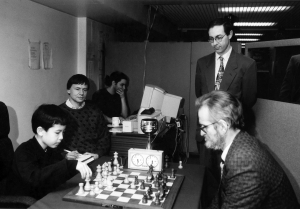
Andrew Whiteley playing a challenge match against 9 year old David Howell in the year 2000. I am in the picture too as I was scoring the game. Looking on is Barry Gale, organiser of the Kensington tournaments at the time, and Alexis Harakis is at the computer analysing the game on Fritz. © Mark Huba
But now it is time to draw the topic to a close: “Too many facts and figures…” I already hear you complaining – “Who does he think he is, Edward Winter?”
All of which, quite naturally, brings to mind the subject of chess history, and it is with this that I wish to conclude. About a year ago I attended a special ceremony to re-dedicate the newly restored grave of the nineteenth-century world title challenger, Johannes Zukertort, in Brompton Cemetery, West London. This was a marvellous initiative driven by grandmaster Stuart Conquest and with generous support from Polish clergy and embassy officials. And at this well-attended gathering, I happened to meet my erstwhile opponent, Andrew Whiteley, who enjoyed informing me of his ‘genealogical line’ leading straight back to the great man himself! You see, he had played chess against Leonard Barden, who had played against the German grandmaster Jacques Mieses, who had played Zukertort in the 1800s – three generations and a span of one hundred and twenty five years! There and then I asked myself, should this now be entered in the Guinness Book of Records – or perhaps even on ancestry.com ?

